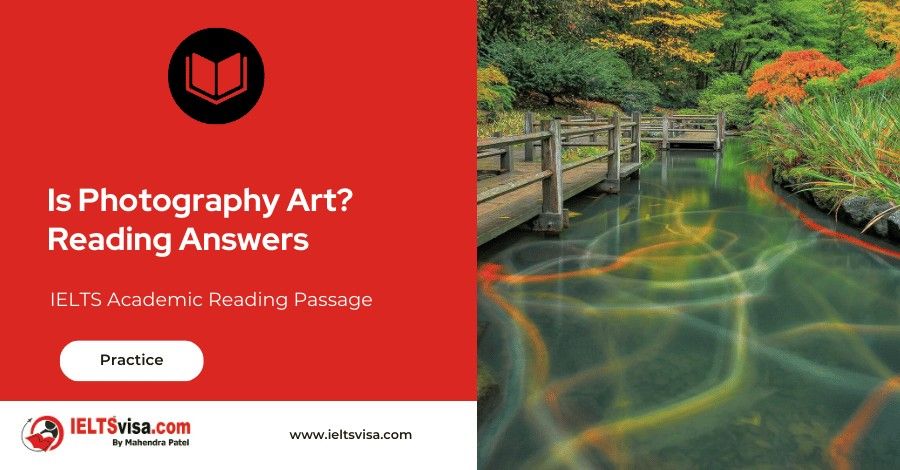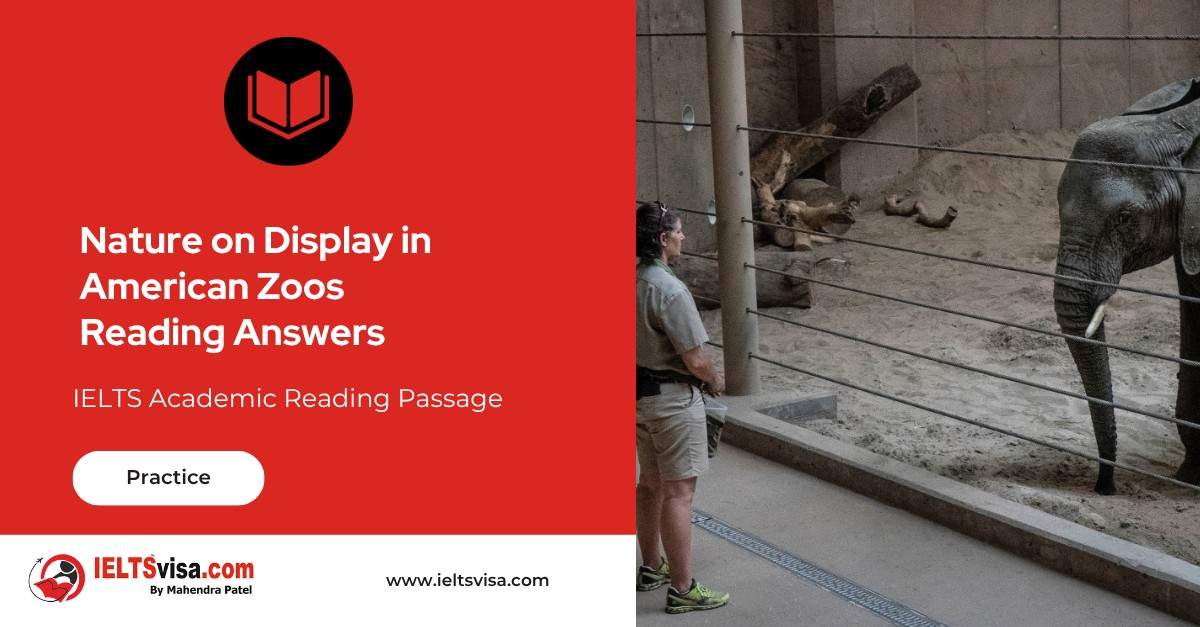Is Photography Art? Reading Answers
IELTS Academic Reading Passage
This may seem a pointless question today. Surrounded as we are by thousands of photographs, most of us take for granted that, in addition to supplying information and seducing customers, camera images also serve as decoration, afford spiritual enrichment, and provide significant insights into the passing scene. But in the decades following the discovery of photography, this question reflected the search for ways to fit the mechanical medium into the traditional schemes of artistic expression.
The much-publicized pronouncement by painter Paul Delaroche that the daguerreotype* signalled the end of painting is perplexing because this clever artist also forecast the usefulness of the medium for graphic artists in a letter written in 1839. Nevertheless, it is symptomatic of the swing between the outright rejection and qualified acceptance of the medium that was fairly typical of the artistic establishment. Discussion of the role of photography in art was especially spirited in France, where the internal policies of the time had created a large pool of artists, but it was also taken up by important voices in England. In both countries, public interest in this topic was a reflection of the belief that national stature and achievement in the arts were related.
From the maze of conflicting statements and heated articles on the subject, three main positions about the potential of camera art emerged. The simplest, entertained by many painters and a section of the public, was that photographs should not be considered ‘art’ because they were made with a mechanical device and by physical and chemical phenomena instead of by human hand and spirit; to some, camera images seemed to have more in common with fabric produced by machinery in a mill than with handmade creations fired by inspiration. The second widely held view, shared by painters, some photographers, and some critics, was that photographs would be useful to art but should not be considered equal in creativeness to drawing and painting. Lastly, by assuming that the process was comparable to other techniques such as etching and lithography, a fair number of individuals realized that camera images were or could be as significant as handmade works of art and that they might have a positive influence on the arts and on culture in general.
Artists reacted to photography in various ways. Many portrait painters – miniaturists in particular – who realized that photography represented the ‘handwriting on the wall’ became involved with daguerreotyping or paper photography in an effort to save their careers; some incorporated it with painting, while others renounced painting altogether. Still other painters, the most prominent among them the French painter, Jean- Auguste-Dominique Ingres, began almost immediately to use photography to make a record of their own output and also to provide themselves with source material for poses and backgrounds, vigorously denying at the same time its influence on their vision or its claims as art.
The view that photographs might be worthwhile to artists was enunciated in considerable detail by Lacan and Francis Wey. The latter, an art and literary critic, who eventually recognised that camera images could be inspired as well as informative, suggested that they would lead to greater naturalness in the graphic depiction of anatomy, clothing, likeness, expression, and landscape. By studying photographs, true artists, he claimed, would be relieved of menial tasks and become free to devote themselves to the more important spiritual aspects of their work.
Wey left unstated what the incompetent artist might do as an alternative, but according to the influential French critic and poet Charles Baudelaire, writing in response to an exhibition of photography in 1859, lazy and untalented painters would become photographers. Fired by a belief in art as an imaginative embodiment of cultivated ideas and dreams, Baudelaire regarded photography as ‘a very humble servant of art and science’; a medium largely unable to transcend ‘external reality’. For this critic, photography was linked with ‘the great industrial madness’ of the time, which in his eyes exercised disastrous consequences on the spiritual qualities of life and art.
Eugene Delacroix was the most prominent of the French artists who welcomed photography as help-mate but recognized its limitations. Regretting that ‘such a wonderful invention’ had arrived so late in his lifetime, he still took lessons in daguerreotyping, and both commissioned and collected photographs. Delacroix’s enthusiasm for the medium can be sensed in a journal entry noting that if photographs were used as they should be, an artist might ‘raise himself to heights that we do not yet know’.
The question of whether the photograph was document or art aroused interest in England also. The most important statement on this matter was an unsigned article that concluded that while photography had a role to play, it should not be ‘constrained’ into ‘competition’ with art; a more stringent viewpoint led critic Philip Gilbert Hamerton to dismiss camera images as ‘narrow in range, emphatic in assertion, telling one truth for ten falsehoods’.
These writers reflected the opposition of a section of the cultural elite in England and France to the ‘cheapening of art’ which the growing acceptance and purchase of camera pictures by the middle class represented. Technology made photographic images a common sight in the shop windows of Regent Street and Piccadilly in London and the commercial boulevards of Paris. In London, for example, there were at the time some 130 commercial establishments where portraits, landscapes, and photographic reproductions of works of art could be bought. This appeal to the middle class convinced the elite that photographs would foster a desire for realism instead of idealism, even though some critics recognized that the work of individual photographers might display an uplifting style and substance that was consistent with the defining characteristics of art.
These writers reflected the opposition of a section of the cultural elite in England and France to the ‘cheapening of art’ which the growing acceptance and purchase of camera pictures by the middle class represented. Technology made photographic images a common sight in the shop windows of Regent Street and Piccadilly in London and the commercial boulevards of Paris. In London, for example, there were at the time some 130 commercial establishments where portraits, landscapes, and photographic reproductions of works of art could be bought. This appeal to the middle class convinced the elite that photographs would foster a desire for realism instead of idealism, even though some critics recognized that the work of individual photographers might display an uplifting style and substance that was consistent with the defining characteristics of art.
Questions 27-30
Choose the correct letter, A, B, C or D.
Write your answers in boxes 27-30 on your answer sheet.
27. What is the writer’s main point in the first paragraph?
A. photography is used for many different purposes.
B. photographers and artists have the same principal aims.
C. Photography has not always been a readily accepted art form.
D. photographers today are more creative than those of the past.
28. What public view about artists was shared by the French and the English?
A. that only artists could reflect a culture’s true values
B. that only artists were qualified to judge photography
C. that artists could lose work as a result of photography
D. that artist success raised a country’s international profile
29. What does the writer mean by “the handwriting on the wall” in the second line of paragraph 4?
A. an example of poor talent
B. a message that cannot be trusted
C. an advertisement for something new
D. a signal that something bad will happen
30. What was the result of the widespread availability of photographs to the middle classes?
A. The most educated worried about its impact on public taste.
B. It helped artists appreciate the merits of photography.
C. Improvements were made in photographic methods.
D. It led to a reduction in the price of photographs.
Questions 31-34
Complete the summary of Paragraph 3 using the list of words, A-G, below.
Write your answers in boxes 31-34 on your answer sheet.
A) inventive C) beneficial E) mixed G) inferior
B) similar D) next F) justified
Camera art
In the early days of photography, opinions on its future were 31 ………………………., but three clear views emerged. A large number of artists and ordinary people saw photographs as 32 ………………………. to paintings because of the way they were produced. Another popular view was that photographs could have a role to play in the art world, despite the photographer being less 33…………………………. Finally, a smaller number of people suspected that the impact of photography on art and society could be 34………………………
Questions 35-40
Look at the following statements and the list of people, A-E, below.
Match each statement with the correct person.
Write the correct letter, A-E, in boxes 35-40 on your answer sheet.
35.He claimed that photography would make paintings more realistic.
36.He highlighted the limitations and deceptions of the camera.
37. He documented his production of artwork by photographing his works.
38. He noted the potential for photography to enrich artistic talent.
39. He based some of the scenes in his paintings on photographs.
40. He felt photography was part of the trend towards greater mechanisation.
A. Jean-Auguste-Dominique Ingres
B. Francis Wey
C. Charles Baudelaire
D. Eugene Delacroix
E. Philip Gilbert Hamerton

Solution For: Is Photography Art?
Reading Answers
| 27 C | 28 D |
| 29 D | 30 A |
| 31 E | 32 G |
| 33 A | 34 C |
| 35 B | 36 E |
| 37 A | 38 D |
| 39 A | 40 C |
Review and Practice
- Regularly practice with IELTS reading samples and time yourself to get used to the pressure of the exam.
- Review your mistakes to understand where you went wrong and how to avoid similar errors in the future.
Our Books
Master IELTS Speaking Part 1
IELTS Writing Task 1 Book
IELTS Writing Task 2 Book
Is Photography Art? Reading Answers Explanation
Comin Soon
Practice IELTS Other Modules
IELTS Listening
The IELTS Listening test assesses how well you can understand spoken English in various contexts. It lasts about 30 minutes and is divided into four sections with a total of 40 questions. The listening tasks become increasingly difficult as the test progresses.
IELTS Academic Reading
The IELTS Academic Reading section assesses your ability to understand and interpret a variety of texts in academic settings. It is designed to evaluate a range of reading skills, including skimming for gist, reading for main ideas, reading for detail, understanding inferences, and recognizing a writer's opinions and arguments.
IELTS Speaking
The IELTS Speaking test assesses your ability to communicate in English on everyday topics. It lasts 11-14 minutes and consists of three parts: introduction, cue card, and a discussion based on the cue card topic.
IELTS General Reading
IELTS General Reading tests your ability to understand and interpret various types of texts. Here are some key areas and types of content you can expect to encounter in the reading section, along with tips for effective preparation.
IELTS Academic Writing Task 1
In IELTS Academic Writing Task 1, you are presented with a visual representation of information, such as graphs, charts, tables, or diagrams, and you are required to summarize, compare, or explain the data in your own words.
IELTS General Writing Task 1
In IELTS General Writing Task 1, you are required to write a letter based on a given situation. The letter can be formal, semi-formal, or informal, depending on the prompt. Here’s a breakdown of the key components to include in your letter
IELTS Academic Writing Task 2
In IELTS Academic Writing Task 2, you are required to write an essay in response to a question or topic. Here’s a guide to help you understand the essential elements of this task
IELTS Exam Tips
To succeed in the IELTS exam, practice regularly, familiarize yourself with the test format, improve your vocabulary, develop time management skills, and take mock tests to build confidence.
Grammer for IELTS
Grammar is the foundation of effective communication in English. Understanding tense usage, subject-verb agreement, and sentence structure enhances clarity and coherence in writing and speaking.
Vocabulary for IELTS
Vocabulary plays a crucial role in the IELTS (International English Language Testing System) exam, especially in the Speaking and Writing sections. Here’s an overview of why vocabulary is important and how it impacts your performance
RECENT IELTS SAMPLES QUESTIONS AND ANSWERS
Walking with dinosaurs
Peter L. Falkingham and his colleagues at Manchester University are developing techniques that...
Money as the Unit of Amount Reading Answers
The most difficult aspect of money to understand is its function as a unit of account. In...
WEATHERING IN THE DESERT
In the deserts, as elsewhere, rocks at the earth's surface are changed by weathering, which...
Nature on Display in American Zoos
The first zoo in the United States opened in Philadelphia in 1874, followed by the Cincinnati...
Can We Prevent the Poles From Melting
Such is our dependence on fossil fuels, and such is the volume of carbon dioxide we have...
Air conditioning the earth reading answers
The circulation of air in the atmosphere is activated by convection, the transference of heat...













